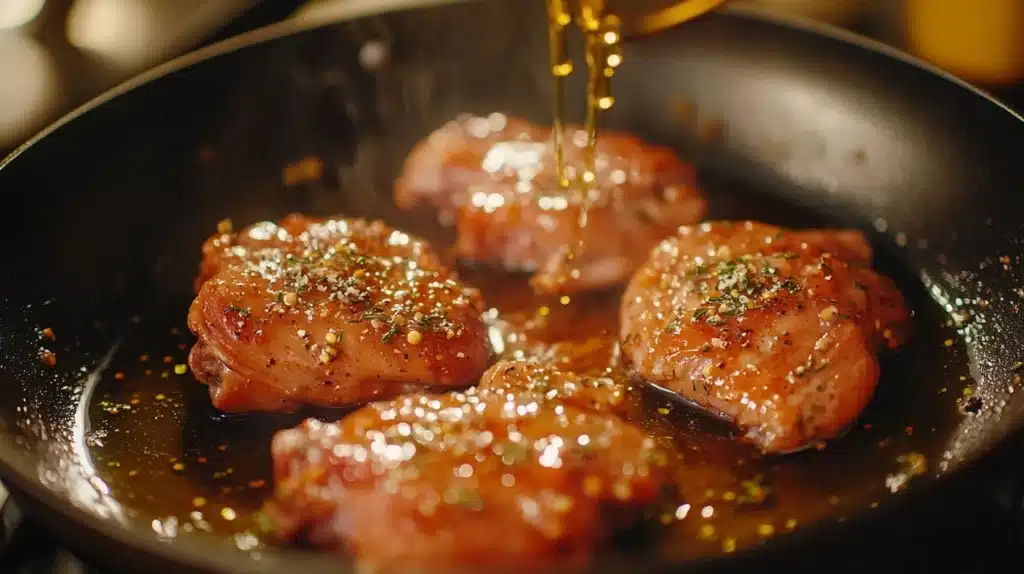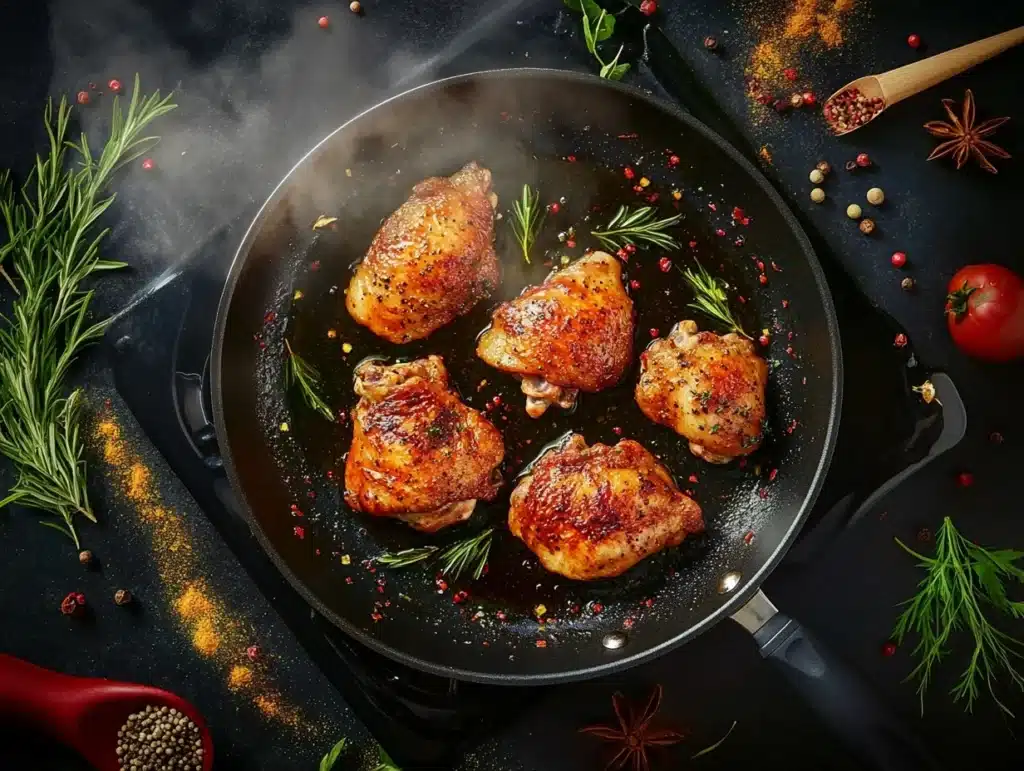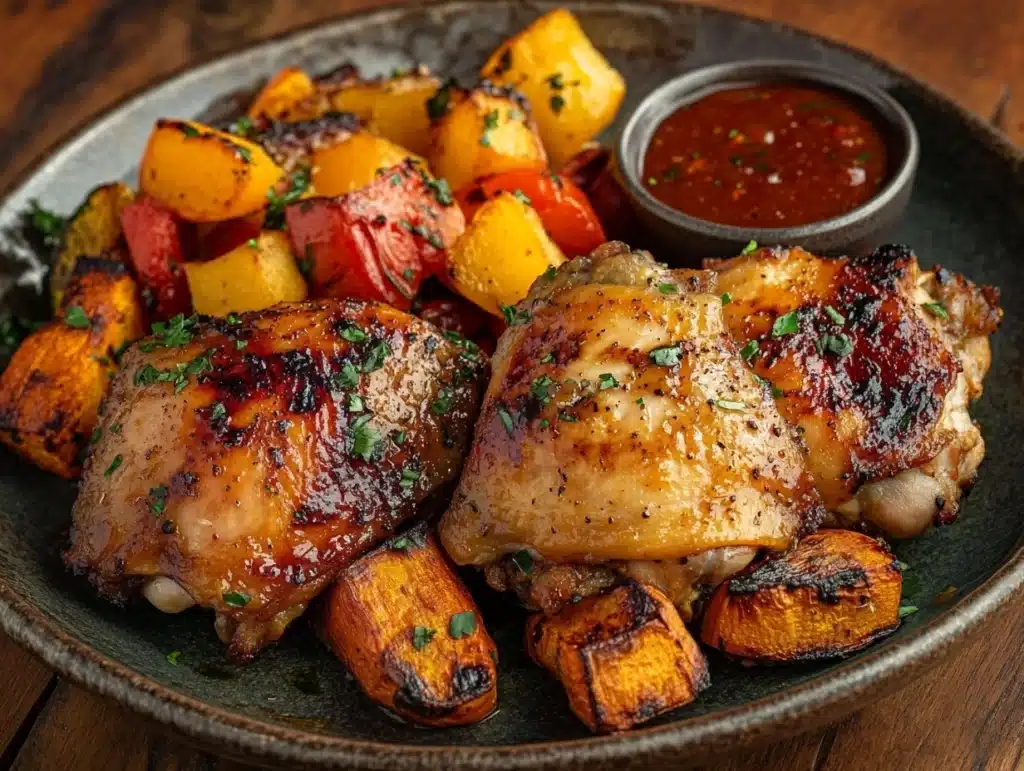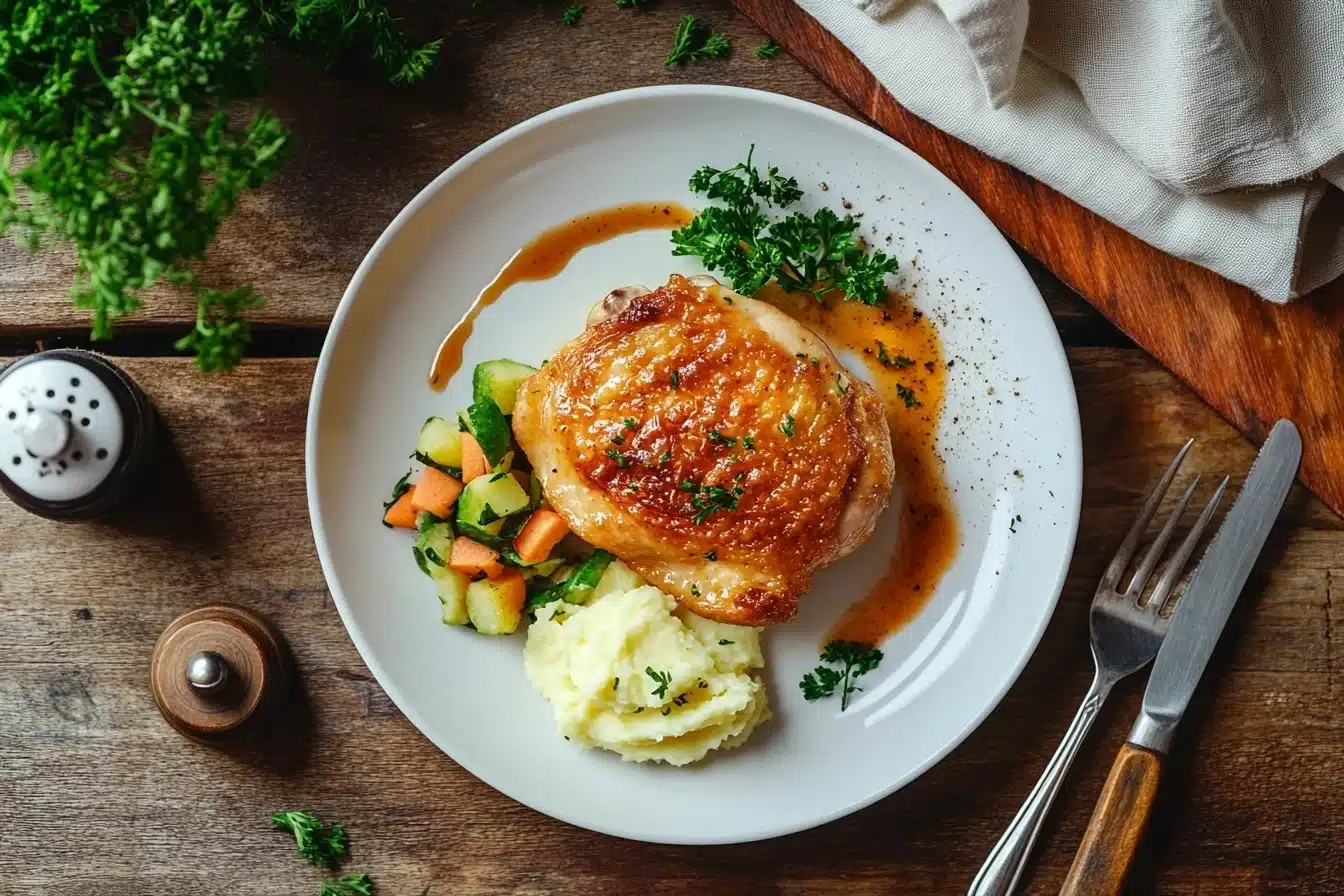Knowing how long to pan fry boneless chicken thighs is essential for achieving the perfect balance of crispy outside and juicy inside. This guide covers everything from preparation and cooking techniques to serving ideas and common mistakes to avoid. Whether you’re a beginner or a seasoned home cook, this straightforward approach will help you pan-fry boneless chicken thighs to perfection every time. Let’s get started!
Understanding Pan-Frying Boneless Chicken Thighs
What Makes Pan-Frying Ideal for Boneless Chicken Thighs?
Pan-frying is a quick and effective way to cook boneless chicken thighs, giving them a crispy outer layer while locking in moisture. This method works especially well because these thighs have enough fat to keep them tender without needing a lot of added oil.
Benefits of Cooking Boneless Chicken Thighs in a Pan
Why choose this method? Well, it’s not just about the flavor. Pan-frying is convenient, doesn’t require fancy tools, and lets you achieve a restaurant-quality finish right at home. Plus, it works beautifully with different seasonings and marinades.
Why Timing Matters in Pan-Frying
Cooking boneless chicken thighs to the right temperature is essential. Too short, and you risk undercooking. Too long, and the thighs might dry out or become rubbery. That perfect golden crust and juicy inside? It’s all about timing and technique.
If you’re looking for a step-by-step guide to mastering the art of pan-frying chicken and achieving crispy perfection every time, check out The Ultimate Guide to Pan-Fried Chicken. This resource dives deeper into tips and techniques for perfecting your pan-frying skills.
Selecting Quality Boneless Chicken Thighs
When it comes to boneless chicken thighs, freshness is key. Look for thighs with a pinkish hue and minimal discoloration. Fresh chicken should have a neutral smell—anything sour or overly strong could indicate spoilage. Check the packaging for a tight seal and ensure the expiration date is current.
If you’re at a butcher, don’t hesitate to ask about the sourcing of the chicken. Locally sourced, organic thighs often have better flavor and texture. Frozen thighs can work too, but they should be thawed properly to avoid uneven cooking. Always inspect for excess fat or tiny bone fragments that may need trimming before cooking.
Finally, consider portion sizes. Standard boneless chicken thighs are uniform in shape, making them ideal for even pan-frying. Choosing similar sizes ensures they cook at the same pace, saving you from the guesswork.
Essential Equipment for Pan-Frying
A well-equipped kitchen makes all the difference when pan-frying. Start with a heavy-bottomed skillet, such as cast iron or stainless steel, which distributes heat evenly and holds the perfect temperature for boneless chicken thighs. A good non-stick pan works too, especially for beginners.
Next, select a spatula that’s sturdy yet gentle enough to flip the thighs without tearing them. Silicone or metal spatulas are great options. Don’t forget a pair of tongs for easy handling!
A meat thermometer is a must-have to ensure the chicken reaches the ideal internal temperature of 165°F. Lastly, use a bowl or plate lined with paper towels for resting the thighs after cooking. This allows excess oil to drain off, giving you a cleaner finish.
Preparing the Chicken Thighs
Trimming Excess Fat
Excess fat can lead to uneven cooking and overly greasy results. With a sharp kitchen knife, carefully trim visible fat from the edges of the thighs. Don’t remove all the fat, though—it adds flavor and helps keep the meat moist during cooking.
Patting Dry to Remove Moisture
Moisture is the enemy of crispiness. Before seasoning or marinating, pat the thighs dry with paper towels. This step ensures that the surface sears properly, giving you that coveted golden crust.
Once prepped, inspect the thighs for any remaining bone fragments or sinew. Removing these ensures a smooth texture and better cooking experience. Cleanliness counts too—wash your hands and tools thoroughly after handling raw chicken to avoid contamination.

Marinating and Seasoning Options
Basic Seasoning Techniques
For a simple yet flavorful start, rub the boneless chicken thighs with a mix of salt, pepper, and garlic powder. This trio enhances the natural taste of the chicken without overpowering it. Add a pinch of paprika or cayenne if you prefer a little heat.
Marinade Recipes for Enhanced Flavor
Marinating elevates the flavor profile and tenderness. Here’s a quick go-to marinade:
- Ingredients: Olive oil, lemon juice, minced garlic, soy sauce, and a sprinkle of oregano.
- Method: Combine the ingredients in a bowl, then coat the thighs evenly. Let them sit for at least 30 minutes—overnight is even better!
For a sweeter option, mix honey, Dijon mustard, and a splash of apple cider vinegar. This creates a glaze-like marinade that caramelizes beautifully during frying.
Experimenting with different seasonings can lead to new favorites. Whether you love bold spices or subtle herbs, there’s no shortage of ways to flavor pan-fried chicken thighs.
Choosing the Right Oil
The choice of oil is critical when pan-frying boneless chicken thighs. Oils with a high smoke point are the best for this method, as they can withstand the high heat required for perfect frying. Some excellent options include canola oil, vegetable oil, avocado oil, and peanut oil.
Avoid using oils with low smoke points, such as extra virgin olive oil or butter, as they can burn quickly, resulting in an unpleasant taste. For those who want a mild flavor that doesn’t overpower the chicken, grapeseed oil is a fantastic choice.
Using the right oil not only prevents burning but also ensures the chicken cooks evenly and develops a beautifully crisp exterior. Keep the quantity in check—just enough to coat the bottom of the pan to avoid greasy results.
Heating the Pan: Temperature Guidelines
Importance of Preheating the Pan
Before placing boneless chicken thighs in the pan, preheating is a must. A cold pan can cause the chicken to stick, leading to uneven cooking. Preheating ensures that the thighs sear quickly, locking in the juices and creating a delightful crust.
Optimal Temperature Settings
Set your stovetop to medium-high heat to achieve the perfect frying temperature. When the pan is properly heated, a small drop of water will sizzle and evaporate almost instantly. Once that happens, add your oil and let it heat for another 30 seconds before adding the chicken.
Patience pays off—resist the urge to crowd the pan. Overcrowding lowers the pan’s temperature, causing the chicken to steam rather than fry. Cook in batches if necessary.
Cooking Time and Techniques
Step-by-Step Guide to Pan-Frying Boneless Chicken Thighs
- Prepare the Pan and Oil: Preheat the pan and add oil as described earlier.
- Place the Chicken: Lay the boneless chicken thighs flat in the pan, ensuring they don’t overlap.
- Let It Sizzle: Allow the first side to cook undisturbed for 4–5 minutes. This builds a crispy, golden crust.
- Flip Carefully: Use tongs or a spatula to flip each piece. Cook the second side for 3–4 minutes.
- Monitor Progress: Check for even browning and adjust heat if necessary.

Recommended Cooking Times for Each Side
For standard-thickness thighs:
- First Side: 4–5 minutes.
- Second Side: 3–4 minutes.
Thicker thighs may require additional time, while thinner ones may cook faster.
Ensuring Even Cooking Throughout
Move the chicken occasionally to different parts of the pan to ensure uniform heat distribution. Covering the pan briefly during the last minute can help retain moisture and cook the chicken evenly without drying it out.
Checking for Doneness
Using a Meat Thermometer
A meat thermometer is the most reliable way to check for doneness. Insert it into the thickest part of the thigh, avoiding contact with the pan. The ideal internal temperature for boneless chicken thighs is 165°F (74°C).
Visual Cues to Determine Doneness
If you don’t have a thermometer, look for these signs:
- The juices should run clear when you cut into the meat.
- The chicken’s color should be white throughout with no pink in the center.
- The surface should be golden and crisp.
Using these techniques ensures your pan-fried chicken thighs are cooked safely and taste incredible every time.
Resting the Chicken
After frying boneless chicken thighs, letting them rest is crucial for juicy and flavorful meat. When the thighs come off the heat, their internal juices are still active due to residual heat. If you cut into them immediately, those juices will escape, leaving the meat dry.
Resting allows the juices to redistribute evenly throughout the thighs, ensuring every bite is tender. Place the chicken on a clean plate or cutting board and cover it loosely with aluminum foil to retain heat. About 5–7 minutes of rest time is usually enough to make a noticeable difference.
This short pause is the secret to turning a good meal into a great one. It also gives you time to prepare the perfect sides and sauces for serving.
Side Dishes to Complement Pan-Fried Chicken Thighs
Pan-fried boneless chicken thighs pair wonderfully with a variety of side dishes, creating a balanced and satisfying meal.
Starches
- Mashed Potatoes: Creamy and comforting, mashed potatoes absorb the juices from the chicken beautifully.
- Rice Pilaf: A lightly seasoned rice pilaf adds texture and flavor without overpowering the main dish.
- Crispy Potato Wedges: For a hearty option, serve crispy wedges seasoned with paprika and garlic.
Vegetables
- Steamed Broccoli: A simple and nutritious addition that balances the richness of fried chicken.
- Roasted Asparagus: Lightly seasoned asparagus spears bring a touch of elegance to the plate.
- Caramelized Carrots: Sweet and savory carrots complement the savory chicken flavors.
Salads
- Mixed Greens with Lemon Vinaigrette: A zesty salad refreshes the palate and adds a healthy crunch.
- Coleslaw: Creamy or tangy coleslaw offers a delightful contrast to the crispy chicken.
- Quinoa Salad: Nutritious and flavorful, a quinoa salad with cucumber and feta is a great pairing.
These side dishes cater to different tastes and dietary preferences, making them versatile companions for your meal.

Sauce Pairings
Sauces can elevate the flavor of boneless chicken thighs, adding a new dimension to every bite.
Classic Options
- Honey Mustard Sauce: Sweet and tangy, this sauce complements the crispy exterior of pan-fried chicken.
- Garlic Butter Sauce: Rich and savory, garlic butter enhances the chicken’s natural flavors.
- Barbecue Sauce: Smoky and slightly sweet, barbecue sauce is a classic choice that never fails.
Creative Choices
- Chimichurri: This Argentine herb-based sauce offers a vibrant and zesty contrast.
- Yogurt-Tahini Sauce: Creamy and slightly nutty, it pairs well with spiced chicken thighs.
- Mango Salsa: A fruity salsa adds brightness and a hint of tropical sweetness.
Experiment with these sauces to discover your favorites, and don’t hesitate to mix and match to suit your taste!
Common Mistakes to Avoid When Cooking Pan-Fried Chicken Thighs
Even with the best techniques, a few common missteps can derail the process of cooking perfect pan-fried chicken thighs. Avoid these pitfalls for a hassle-free and delicious experience:
Overcrowding the Pan for Skillet-Fried Chicken
It might be tempting to cook all the thighs at once, but overcrowding the pan lowers the temperature, leading to steaming instead of frying. This results in soggy chicken without the crispy exterior you’re aiming for. If you’re working with fried chicken recipes that call for multiple pieces, cook in batches to maintain consistent heat and allow enough room for the thighs to fry properly.
Incorrect Oil Temperature for Crispy Chicken Thighs
Starting with oil that’s too cold leads to greasy chicken, while overly hot oil can burn the exterior before the inside is fully cooked. Use medium-high heat and test with a small drop of water—it should sizzle immediately but not splatter aggressively. For boneless chicken thigh cooking time, maintaining the right temperature is key to achieving that crisp, golden finish.
Overcooking or Undercooking Skillet-Fried Chicken
Timing is critical when making pan-fried chicken thighs. Overcooked thighs become dry and chewy, while undercooked chicken poses health risks. Use a meat thermometer to ensure the thighs reach an internal temperature of 165°F. If you don’t have a thermometer, look for visual cues, such as clear juices and a golden-brown surface, to help gauge doneness.
Avoiding these common mistakes will ensure your crispy chicken thighs turn out perfectly cooked every time!
Achieving Crispy Skin on Boneless Chicken Thighs
Achieving a crispy exterior on boneless chicken thighs without skin might seem tricky, but it’s entirely possible with the right approach.
Patting the Chicken Dry
Excess moisture prevents browning, so always pat the thighs dry with paper towels before seasoning or cooking.
Using Cornstarch or Flour
Lightly dusting the thighs with cornstarch or all-purpose flour creates a crisp crust. Mix the flour with your preferred spices for extra flavor.
Maintaining Proper Heat
Consistent medium-high heat is essential for crispiness. A preheated pan and high-smoke-point oil help the thighs cook evenly while developing a golden crust.
Pressing the Chicken Gently
While frying, press the thighs lightly with a spatula to ensure even contact with the pan. This helps achieve a uniform crust on every piece.
Avoid Flipping Too Early
Let the thighs cook undisturbed for at least 4–5 minutes on the first side. This gives the crust time to form without sticking to the pan.
Adjusting Cooking Times for Different Thicknesses
The thickness of boneless chicken thighs can vary, and cooking times should be adjusted accordingly. Here’s how to adapt your technique for perfect results:
| Thickness | First Side | Second Side | Additional Notes |
|---|---|---|---|
| Thin (< 1 inch) | 3–4 minutes | 2–3 minutes | Watch closely to avoid overcooking. |
| Medium (1–1.5 inches) | 4–5 minutes | 3–4 minutes | Check internal temperature midway. |
| Thick (> 1.5 inches) | 5–6 minutes | 4–5 minutes | Lower the heat slightly for even cooking. |
Tips for Thick Thighs
- Cover the pan briefly during cooking to trap heat and cook the center.
- Reduce heat to medium after the first side is seared to prevent burning.
Tips for Thin Thighs
- Keep an eye on the chicken, as thin pieces cook faster and are prone to drying out.
By adjusting your cooking times based on size, you can enjoy perfectly cooked boneless chicken thighs every time.
Frequently Asked Questions (FAQs)
How long should I pan-fry boneless chicken thighs?
The cooking time for boneless chicken thighs largely depends on their thickness. On average:
- For medium-thick thighs (1–1.5 inches), cook for 4–5 minutes on the first side and 3–4 minutes on the second side over medium-high heat.
- Thinner thighs require slightly less time, about 3–4 minutes per side.
- Thicker thighs may take 5–6 minutes on the first side and 4–5 minutes on the second side.
Always ensure the internal temperature reaches 165°F for safety.
How to pan-fry chicken sausage
Pan-frying chicken sausage is simple and quick:
- Preheat the Pan: Use medium heat and a small amount of oil to coat the pan lightly.
- Add the Sausages: Place sausages in the pan, ensuring they don’t touch each other.
- Cook Evenly: Turn them every 2–3 minutes to achieve even browning on all sides. Total cooking time is typically 8–10 minutes.
- Check Doneness: Ensure the internal temperature is 165°F or that juices run clear when pierced.
For a detailed, step-by-step guide on preparing perfectly cooked chicken sausage, check out How to Pan Fry Chicken Sausage: A Step-by-Step Guide. This guide covers everything you need for a quick, delicious result.
Why soak chicken in milk before frying?
Soaking chicken in milk before frying is a classic method to tenderize the meat and enhance its flavor. According to Healthline, the lactic acid in milk helps break down proteins, resulting in a softer texture and better seasoning absorption. This technique is particularly useful when preparing pan-fried chicken thighs, as it ensures they stay moist and delicious.
For extra flavor, consider adding spices like garlic powder, paprika, or herbs to the milk soak. Buttermilk is often used as an alternative for even richer flavor and better results.
For a deeper understanding of why soaking chicken in milk improves tenderness and flavor, read Why Soak Chicken in Milk Before Frying? A Complete Guide. This guide explains the science and benefits behind this technique.
Is it better to pan-fry chicken in butter or oil?
Both butter and oil have their advantages, but oil is typically better for pan-frying boneless chicken thighs. Here’s why:
- Oil: High-smoke-point oils like canola, vegetable, or avocado oil can handle the high heat required for frying without burning.
- Butter: While butter adds a rich flavor, it has a low smoke point and can burn quickly.
For the best of both worlds, use a mix of oil and butter. Start frying with oil and add a small knob of butter at the end for flavor. For a detailed comparison of butter and oil in pan-frying, including pros, cons, and cooking tips, visit Pan Frying Chicken: Butter or Oil – Which is Better?. It’s the perfect resource for making an informed choice.
Can I use frozen boneless chicken thighs for pan-frying?
Yes, you can pan-fry frozen boneless chicken thighs, but it requires extra care. Here’s how:
- Thaw if Possible: Ideally, thaw chicken in the refrigerator overnight for even cooking.
- If Cooking Directly from Frozen:
- Use lower heat to ensure the center cooks thoroughly.
- Cover the pan to trap steam and speed up cooking.
- Increase the cooking time by 50% and check for doneness with a meat thermometer.
- Be Cautious with Oil: Frozen chicken may release water as it cooks, so be mindful to avoid oil splatter.
Cooking frozen chicken thighs can work in a pinch, but for the best results, thawing is recommended.
Mastering the Art of Pan-Frying Boneless Chicken Thighs
Learning how long to pan fry boneless chicken thighs is essential for consistently juicy and flavorful results. This cooking method delivers a crispy exterior and tender inside when done right. Start by choosing high-quality chicken, preparing it properly by trimming excess fat and patting it dry, and selecting the right oil with a high smoke point. Preheating your pan and monitoring the temperature are crucial to avoid sticking or burning.
To determine how long to pan fry boneless chicken thighs, cook them evenly by browning each side for the recommended time and ensuring the internal temperature reaches 165°F. Resting the chicken before serving is just as important, as it locks in juices, making every bite succulent and satisfying.
Don’t be afraid to experiment! Whether it’s trying a new marinade, dusting the thighs with your favorite spices, or pairing them with creative side dishes, there’s plenty of room to make each meal unique. With these tips, you’ll master not only the technique but also how long to pan fry boneless chicken thighs for perfection. So, grab your skillet, fire up the stove, and let the sizzling magic begin!

